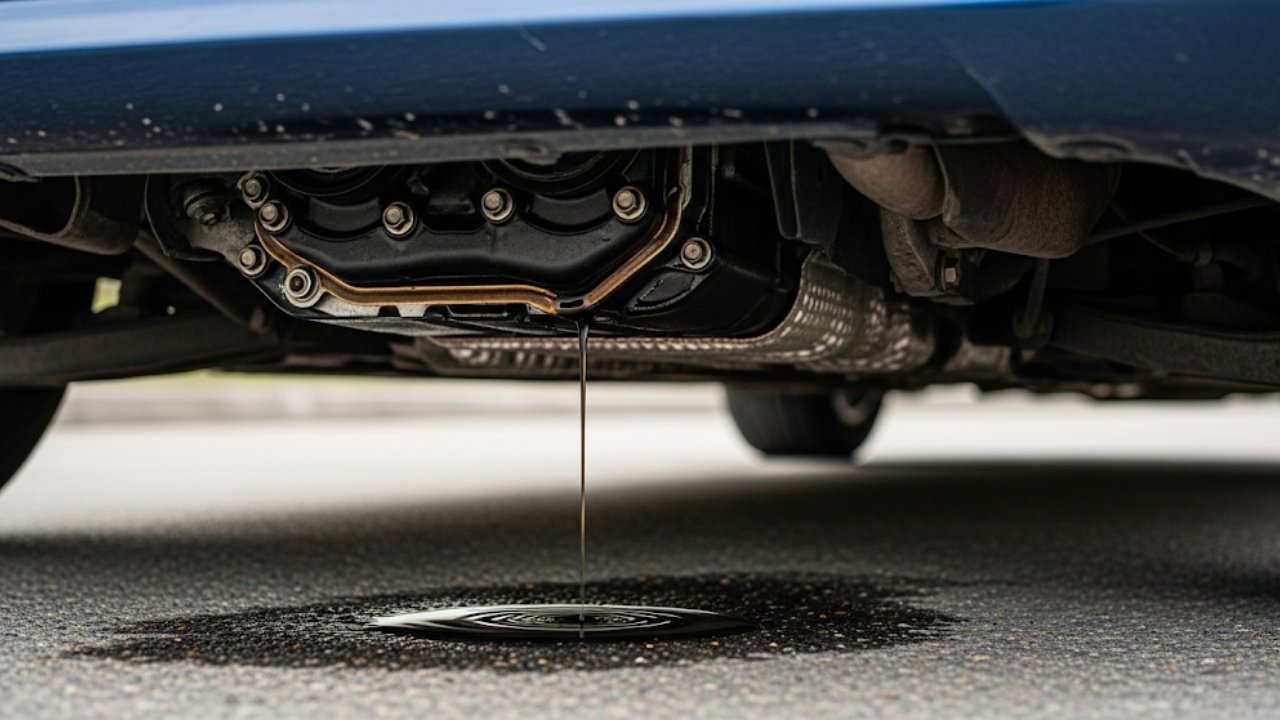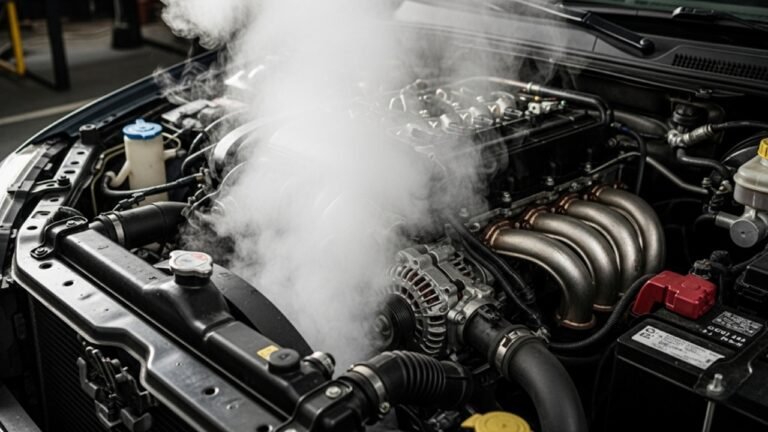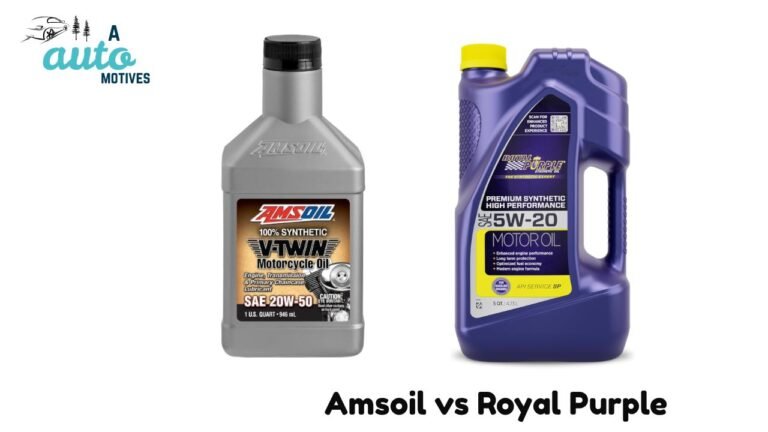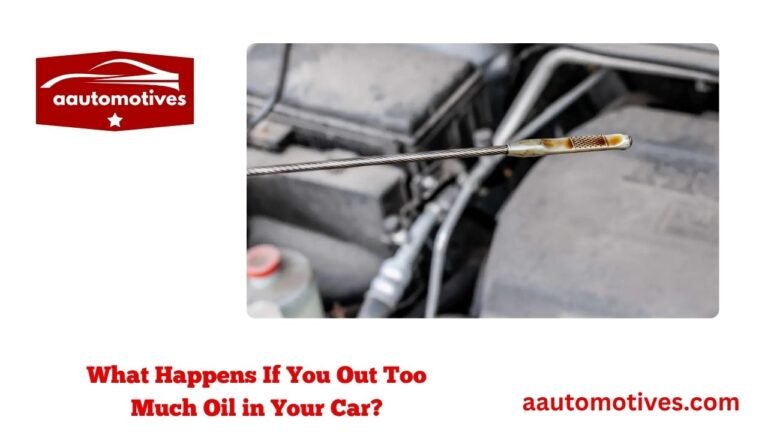Oil Leak in Car Symptoms: Know the Signs Before It’s Too Late

Ever walked up to your car in the morning and noticed a dark puddle right beneath the engine? That little patch could be whispering something serious—an oil leak in your car. While it may seem harmless at first, ignoring it is like ignoring a sore tooth. It doesn’t go away. It gets worse. Trust me, I’ve been there.
In this guide, we’re diving deep into the symptoms of oil leaks in cars, how to spot them early, and what you should do next. Whether you’re a first-time car owner or a seasoned driver, these insights will help you protect your engine, your wallet, and your peace of mind.
Let’s break this down into clear, friendly, and practical advice—just like we’re chatting over coffee while peeking under your car hood.
In This Article
- 1 Why Oil Leaks Matter More Than You Think
- 2 1. Dark or Brown Puddle Under the Car
- 3 2. Burning Oil Smell While Driving
- 4 3. Blue Smoke from the Exhaust Pipe
- 5 4. Engine Oil Warning Light On
- 6 5. Oil Coating on Engine Parts
- 7 6. Engine Overheating
- 8 7. Poor Fuel Efficiency
- 9 8. Rough Engine Idle or Misfires
- 10 9. Low Oil Levels Between Oil Changes
- 11 What Causes an Oil Leak in a Car?
- 12 How to Fix an Oil Leak in a Car
- 13 Can You Drive With an Oil Leak?
- 14 How to Prevent Oil Leaks in the First Place
- 15 Cost of Fixing Oil Leak in a Car
- 16 FAQs About Oil Leak in Car Symptoms
- 16.1 1. Is an oil leak dangerous?
- 16.2 2. Can I use stop-leak additives?
- 16.3 3. How do I know where my car is leaking oil from?
- 16.4 4. How long can I drive with an oil leak?
- 16.5 5. Does synthetic oil cause leaks?
- 16.6 6. Can an oil leak damage my transmission?
- 16.7 7. Why does my car still leak after a gasket replacement?
- 16.8 8. Is fixing an oil leak worth it for an old car?
- 17 Final Thoughts: Don’t Ignore the Signs
Why Oil Leaks Matter More Than You Think

Here’s why it matters:
-
Oil lubricates your engine. Without it, metal parts grind, overheat, and wear out fast.
-
Leaks can damage other parts. Think belts, hoses, or your catalytic converter.
-
Oil fires are rare but real. Hot oil dripping on engine parts can ignite.
-
Low oil means low pressure. Your dashboard light may warn you, but sometimes it’s too late.
Bottom line: Catching the symptoms of an oil leak in a car early is the easiest way to avoid a disaster later.
1. Dark or Brown Puddle Under the Car
The most obvious symptom? A brown or black puddle under your vehicle. It might look small, but don’t underestimate it.
A fresh oil leak usually shows up as:
-
Amber or golden brown if your oil is clean.
-
Dark brown or black if it’s old or dirty.
-
Slick, shiny, and greasy to the touch.
These puddles typically appear under the front of the engine, where oil tends to drip from gaskets, seals, or the oil pan.
Pro tip: Slide a clean piece of cardboard under the car overnight. In the morning, check for spots. That’s your clue.
✨ Relatable moment: I once blamed my dog for tracking oil in the garage—until I noticed the same spots in the parking lot at work. Turns out, it was my car crying for help.
2. Burning Oil Smell While Driving
Ever caught a whiff of something like burning rubber or a smoky barbecue while cruising down the road?
That smell isn’t your neighbor grilling. It’s likely burning engine oil—a top sign of a leak.
When oil leaks onto hot engine parts like the exhaust manifold, it sizzles and releases a strong, acrid odor. If you smell it:
-
Don’t ignore it. It can point to a valve cover gasket leak or oil filter seal issue.
-
Pull over and check for smoke or heat.
-
Look under the hood—but be careful, parts can be hot.
Oil leak in car symptoms don’t always show themselves in puddles. Sometimes, your nose knows first.
3. Blue Smoke from the Exhaust Pipe
Let’s talk about tailpipe smoke. No, not the normal white vapor you see on chilly mornings. I mean blue-gray smoke that makes your car look like a mini steam engine.
This smoke is a big red flag that oil is leaking into the combustion chamber and being burned with fuel. Common culprits include:
-
Worn piston rings
-
Valve seals
-
Head gasket failure
It’s serious, because that means your engine is consuming oil. And guess what? That can lead to total engine failure if left untreated.
Table: Comparing Exhaust Smoke Colors and Their Meanings
| Smoke Color | Possible Cause | Severity |
|---|---|---|
| White (light) | Condensation | Low |
| White (thick) | Coolant leak (blown head gasket) | High |
| Blue | Burning oil (internal oil leak) | Critical |
| Black | Fuel-rich mixture | Medium |
Keep your eye on the rearview. If your car starts fogging the road behind you, it’s time for a serious look under the hood.
4. Engine Oil Warning Light On
Your car’s dashboard is smarter than you think. When the engine oil light flashes, it’s your vehicle’s way of shouting, “Help! I’m running dry!”
This warning can mean:
-
Oil level is too low
-
Oil pressure is dangerously low
-
There’s a leak somewhere in the system
If this light turns on while you’re driving:
-
Pull over safely.
-
Check the oil dipstick.
-
Add oil if it’s low.
-
Look for puddles, drips, or smells.
It’s not just a light. It’s your car begging you to fix the oil leak before things get worse.
5. Oil Coating on Engine Parts
Have you ever popped the hood and noticed sticky residue or grime collecting around the engine?
That’s not just dirt. That’s leaking oil sticking to dust, heat, and engine parts.
Common areas to check:
-
Around the valve cover gasket
-
Near the timing chain cover
-
Around the oil pan or drain plug
When oil leaks, it often doesn’t drip straight down. Instead, it seeps, slides, and sprays across engine parts. That’s why mechanics often shine a UV light on the engine after adding a dye to the oil—it reveals where the leak starts.
If you see any oily buildup, take it seriously. It could be the first visual symptom of a bigger problem hiding deeper in your car’s heart.
6. Engine Overheating
Oil isn’t just about lubrication—it helps cool your engine too. So, if your car is leaking oil, the engine might be running hotter than normal.
Here’s how it plays out:
-
Less oil = more friction
-
More friction = higher engine temperatures
-
High heat = potential engine damage
Even if your coolant is topped off, an oil leak can silently push your engine into dangerous territory.
Quick story: I ignored a mild temperature spike once, thinking my AC was just struggling. A week later, the radiator was fine—but my oil was gone. My mechanic told me that oil starvation caused my piston rings to warp. Painful lesson.
7. Poor Fuel Efficiency
If you’re suddenly visiting the gas station more often—without changing your driving habits—something might be off under the hood. While many blame their engine or tires, the real culprit could be an oil leak.
Here’s how it connects:
-
Oil helps your engine run smoothly.
-
If it’s leaking, the engine has to work harder.
-
This increased friction and stress burn more fuel.
You’ll notice your MPG numbers drop, or you might just feel like your fuel tank empties faster. I once thought my car had become a gas guzzler overnight. A week later, the mechanic showed me a slow oil drip from a worn oil pan gasket. One fix—and boom—my fuel economy jumped back to normal.
A leaky engine doesn’t just lose oil—it loses efficiency, too.
8. Rough Engine Idle or Misfires
Here’s a more subtle but telling symptom: your engine runs rough, especially when stopped at red lights or idling in traffic.
That shaky feeling can be caused by:
-
Oil leaking onto spark plugs
-
Faulty seals near the valve cover
-
Misfires due to contaminated combustion chambers
If your car vibrates or sputters while idling, it could be more than dirty fuel. A hidden oil leak in the engine can foul up your spark, reduce compression, and throw off your timing. It’s like trying to run a race with gum stuck on your shoes.
So next time your ride shakes at a stoplight, don’t just crank up the radio. It might be your engine’s cry for help.
9. Low Oil Levels Between Oil Changes
You shouldn’t have to top off oil frequently if your engine is healthy. If you’re adding oil every few weeks just to stay level, it’s a strong hint you’ve got a hidden oil leak somewhere.
Most engines burn a tiny bit of oil, especially older ones. But if your dipstick keeps coming up dry after only 500–1000 miles, you’re probably leaking or burning oil.
Bullet Points: When Frequent Oil Top-Offs Are NOT Normal
-
Needing oil before 2,000 miles after a change
-
Not seeing oil in the dipstick at all
-
Adding quarts monthly without obvious puddles
This silent leak might not leave visible stains—but it’s just as damaging.
What Causes an Oil Leak in a Car?
Now that you know what to watch for, let’s get into the why. There are several common causes behind oil leaks, and knowing them helps you fix the problem at its root.
Common Causes of Oil Leaks:
| Cause | Description |
|---|---|
| Worn Valve Cover Gasket | Often leaks oil onto the top of the engine |
| Faulty Oil Pan Gasket | Leaks near the bottom, visible as puddles under the car |
| Damaged Oil Filter | Improper installation or cheap filters can leak |
| Bad Oil Drain Plug | Loose or stripped plug after oil change |
| Cracked Engine Block | Rare but serious; visible oil and coolant mix |
| Old or Hardened Seals | Time and heat break down rubber seals throughout the engine |
Each of these issues can start small and worsen over time. Regular checks can save you thousands.
How to Fix an Oil Leak in a Car
Not every leak means a trip to the mechanic. Some are DIY-friendly, while others need professional hands.
DIY Fixes:
-
Tighten drain plug if it’s loose
-
Replace a worn oil filter
-
Use oil stop-leak additives (temporary solution)
-
Replace a valve cover gasket if you’re handy
When to Call a Mechanic:
-
Major leaks or multiple drip points
-
Smoke from engine bay
-
Leaking from head gasket or oil pan
It’s all about your comfort level. For minor leaks, try a quick fix. But when in doubt, always seek expert advice.
Can You Drive With an Oil Leak?
Short answer? Yes—but you shouldn’t.
Here’s why:
-
A small leak can suddenly become a major leak while driving.
-
You risk losing oil pressure, which can destroy your engine.
-
Oil can damage other parts (like belts or rubber hoses).
-
In rare cases, hot oil can lead to an engine fire.
So yes, your car might still run—but driving it is like flying a plane with a crack in the wing. You might land okay. But what if you don’t?
How to Prevent Oil Leaks in the First Place
The best way to deal with an oil leak in a car? Avoid it entirely. Prevention is always cheaper than repair.
Prevention Tips:
-
Change oil regularly (follow the schedule!)
-
Use quality oil filters and gaskets
-
Don’t over-tighten bolts—especially drain plugs
-
Check under the hood monthly for residue or smells
-
Clean your engine occasionally so leaks are easier to spot
Think of this as giving your engine a little self-care. Treat it well, and it won’t leak on you.
Cost of Fixing Oil Leak in a Car
Repair costs can vary wildly based on the source of the leak and your car model.
Table: Average Costs to Repair Oil Leaks
| Repair Needed | Estimated Cost (USD) |
|---|---|
| Oil Filter Replacement | $20 – $50 |
| Valve Cover Gasket | $150 – $300 |
| Oil Pan Gasket | $300 – $600 |
| Head Gasket | $1,000 – $2,500 |
| Full Engine Reseal | $2,000 – $4,000+ |
A cheap part, like a gasket or plug, can lead to expensive damage if ignored. It’s worth investing early.
FAQs About Oil Leak in Car Symptoms
1. Is an oil leak dangerous?
Yes. Even a small leak can lead to engine damage or fires if ignored.
2. Can I use stop-leak additives?
They can work for minor leaks, but they’re a short-term fix. Don’t rely on them for long.
3. How do I know where my car is leaking oil from?
Check common leak points like the oil filter, pan, valve cover, and drain plug. Or use a UV dye test.
4. How long can I drive with an oil leak?
Only as long as it takes to get to a mechanic. Don’t risk long-distance drives.
5. Does synthetic oil cause leaks?
No. But it can expose existing leaks because of its cleaning properties and flow rate.
6. Can an oil leak damage my transmission?
Not directly. But if oil leaks onto hot parts or belts, it can cause related damage.
7. Why does my car still leak after a gasket replacement?
The problem might be more than one source, or the new gasket wasn’t sealed correctly.
8. Is fixing an oil leak worth it for an old car?
It depends. If the car’s in good shape otherwise, yes. If it has multiple issues, it might be time to reassess.
Final Thoughts: Don’t Ignore the Signs
Oil leak in car symptoms aren’t just nuisances. They’re your car’s way of saying, “Something’s wrong.” From dark puddles to burning smells, every clue matters.
Trust your instincts, check your driveway, listen to your engine, and don’t shrug off the little signs. I learned that lesson the hard way—so you don’t have to.
Take care of your car, and it’ll take care of you.






